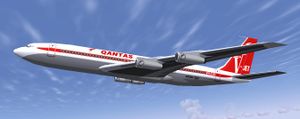The Boeing 707 is a four-engine commercial passenger jet airliner developed by Boeing in the early 1950s. Its name is most commonly spoken as "Seven Oh Seven". Boeing delivered a total of 1010 Boeing 707s, which dominated passenger air transport in the 1960s and remained common through the 1970s. Boeing also offered a smaller, faster version of the aircraft that was marketed as the Boeing 720.
 | |
| Type | Airliner |
|---|---|
| Author(s) | Innis Cunningham, Erik Hofman (FDM) |
| FDM | JSBSim |
| --aircraft= | 707 |
| Status | Development |
| Liveries |
|
Although it was not the first commercial jet in service, the 707 was among the first to be commercially successful, and is generally credited as ushering in the Jet Age. It established Boeing as one of the largest makers of passenger aircraft, and led to the later series of aircraft with "7x7" designations.
Variant 707-338
The 707-338 is/was a convertible passenger/freight configuration which became the most widely produced variant of the 707, the -320C added a strengthened floor and a new cargo door to the -320B model. 335 of these variants were built, including a small number with uprated JT3D-7 engines and a takeoff gross weight of 336,000 lb (152,000 kg). Despite the convertible option, a number of these were delivered as pure freighters.
Development
- The initial standard model was the 707-120 with JT3C engines. Qantas ordered a shorter body version called the 707-138, which was a -120 that had six fuselage frames removed, three in front of the wings, three aft. The frames in the 707 were each 20 inches (500 mm) long, so this resulted in a net shortening of 10 ft (3 m) to 134 ft, 6 inches (41 m). Because the maximum takeoff weight remained the same 257,000 lbs (116 Tonne) as the -120, the 138 was able to fly the longer routes that Qantas needed.
- Braniff ordered the higher-thrust version with Pratt & Whitney JT4A engines, the 707-220.
- The final major derivative was the 707-320 which featured an extended-span wing and JT4A engines.
- The 707-420 was the same as the -320 but with Rolls-Royce Conway turbofan engines. British certification requirements relating to engine-out go-arounds also forced Boeing to increase the height of the tail fin on all 707 variants, as well as add a ventral fin, which was retrofitted on earlier -120 and -220 aircraft. These modifications also aided in the mitigation of dutch roll by providing more yaw stability.